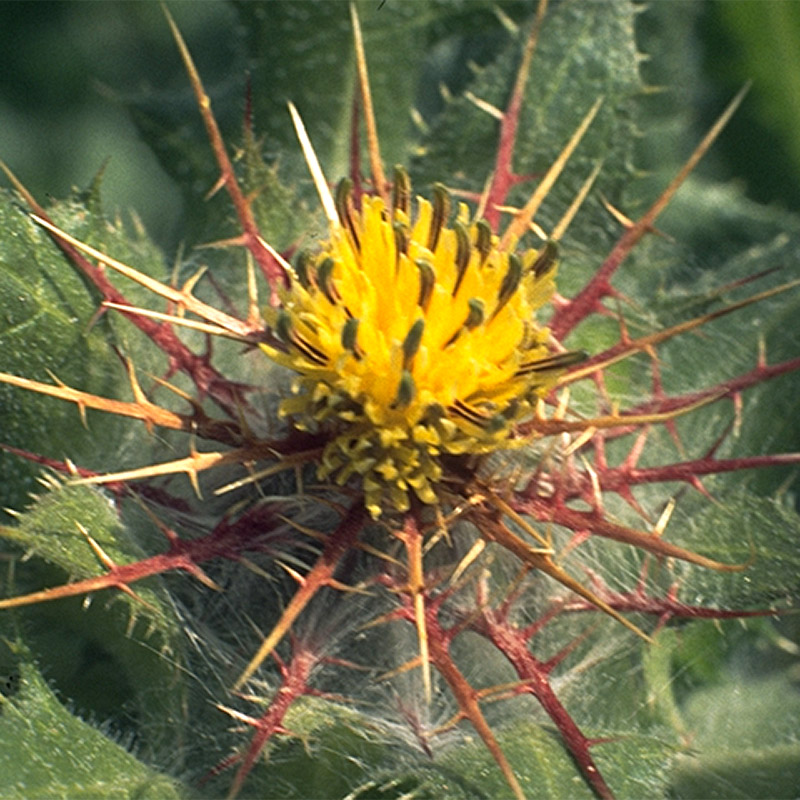Botanical name
Centaurea benedicta (L.) L.
Family
Asteraceae
Common name
Blessed thistle, St. Benedict’s thistle, Holy thistle
Information about the plant
St. Benedict’s thistle is native to the eastern Mediterranean region and the neighboring areas of Asia - Turkey to Afghanistan - and has immigrated to Central and Western Europe. It is cultivated sporadically in Europe and North America, and it grows in moderately dry wastelands.
The genus name Centaurea is derived from the Greek 'kentaureios' (= belonging to the centaurs), Latinized to 'centaurus'. The centaurs originate from Greek mythology and are hybrid creatures combining humans and horses. The species epithet benedictus can be translated as "blessed, praised" (Latin 'benedicere' = to speak well of), describing the much-praised healing powers of the blessed thistle. This interpretation was also adopted in the German name of the plant.
St. Benedict’s thistle is a 10 to 40 cm tall, thistle-like, annual composite with an erect, branched stem. The leaves are alternate, saw-like in shape with spiny margins, and densely covered with glandular hairs. The yellow flower heads are solitary at the end of the stem, surrounded by several rows of green, spiny, pinnatifid bracts. The flower base is silky-haired and covered with numerous spreading leaves; the yellow tubular flowers stand on them. Flowering time is June/July.
Medicinally used parts of plants (herbal drug)
The dried aerial parts harvested during the flowering period are used (Benedicte herb, also cardobenedicte herb - Cnici benedicti herba).
The commercially available drug comes from wild collections in Southern and Eastern Europe, as well as Italy and Spain.
Constituents of the herbal drug
St. Benedict’s thistle contains bitter substances of sesquiterpene lactone type (germacrane-type, including cnicin), triterpenes, flavonoids and lignan lactones.
Quality of the drug
The quality of St. Benedict’s thistle (Cnici benedicti herba) is specified in the German Drug Codex (DAC).
Medical applications
Recognised medical use
The HMPC has classified St. Benedict’s thistle as a traditional medicinal product (see "Traditional use").
ESCOP: St. Benedict’s herb has not been evaluated yet.
Traditional use
St. Benedict’s thistle has been classified by the HMPC as a traditional herbal medicinal product (§ 39a AMG). Based on long-standing use, St. Benedict’s thistle can be used orally for temporary loss of appetite and for symptomatic relief of dyspepsia and mild spasmodic disorders of the gastrointestinal tract.
Herbal drug preparations in finished dosage forms
- Cut St. Benedict’s thistle for tea preparation
- Fluid extract in drops
- Hydroalcoholic extract in drops
Dosage
Finished dosage form: see patient information leaflet.
Tea infusion: drink a cup of unsweetened St. Benedict’s thistle tea 2 to 3 times a day 30 minutes before a meal or when symptoms occur.
Preparation of a tea
Pour 150 mL of hot water over 1.5 to 2 g of finely chopped St. Benedict’s thistle and strain after 10 min.
Notes
In case of existing allergies to the daisy family (Asteraceae), you should refrain from taking St. Benedict’s thistle (possible cross-allergy).
No safety studies are available on the use of St. Benedict’s thistle during pregnancy and lactation; use in children under 18 years is not recommended due to lack of evidence.
Side effects
Allergic reactions are possible.
Interactions
None known


